This post may include affiliate links. Thank you for your support.
This Quick Peach Chutney recipe is made with 6 ingredients and ready in 30 minutes or less! It’s the perfect way to use up those juicy summer peaches (or any stone fruits)! This fruit chutney is incredibly versatile! Pair it with cheese, meats and artisan bread to create an easy charcuterie board! Or use it as a delicious topping for pork, chicken and fish! Alternatively, you can use it as a spread for sandwiches, or eat it straight from the jar with a spoon!
Continue to read on for expert tips and tricks for preparing the best quick chutney recipe! Plus, easy ways to customize this flexible recipe! And, don’t miss the recipe video and comprehensive step-by-step photographs showing you exactly how easy it is to make chutney with fresh fruit home!
Update: This post was originally published in July 2018. I made updates to the post below to include more information about fruit chutney. Plus, I’ve included a step-by-step video to show you how easy this homemade peach chutney recipe is to make!
Hi there, virtual friends! Well, it’s almost the end of July, so I figure it’s high time I share the perfect summer bite with you guys! Today’s recipe is so easy and it’s the perfect way to use up that abundance of perfectly sweet, ripe peaches!
Table of Contents
- Peach chutney recipe: overview
- What is chutney?
- What is peach chutney made of?
- What peaches are best for chutney?
- Which vinegar is best to use in chutney?
- How to make peach chutney from scratch?
- Chutney recipe: FAQ
- Tips for serving chutney
- Tips for storing chutney
- Nutritional information
- Recipe testimonials – What people are saying about this recipe
- More peach recipes!
- More homemade condiments and spreads!
- Quick Peach Chutney Recipe
Peach chutney recipe: overview
This peach chutney is spicy, sweet, perfectly fruity and studded with piquant serrano pepper, fresh basil, boozy bourbon and sweet-tart white balsamic vinegar. This flavorful summer chutney is thick and jam-like in texture with tender bite-sized pieces of fresh peaches.
Served with creamy, rich burrata, salty prosciutto, peppery arugula and crusty artisan bread, this seasonal spread is nothing short of epic!
It’s perfect for entertaining, snacking, date-night, picnics, lounging by the pool… essentially, it is perfect for any occasion, anytime!
Why you’ll love this fruit chutney recipe
- Deliciously flavorful! This homemade chutney is fresh, slightly spicy, sweet, fruity, a touch tangy and 100% delicious!
- 6 easy to find ingredients! This recipe requires just six easy-to-find ingredients, along with a few pantry staples!
- Perfect way to use (and preserve!) summer fruit! This beautiful chutney is the perfect way to take advantage of the fresh fruit from you farmer’s market haul! And, it’s a great way to preserve your favorite summer fruit!
- Simple and fast to make! This recipe is straightforward, so easy to prepare and requires just 30 minutes!
- Customizable! You can completely customize this recipe to your specific taste! Try swapping out the peaches for cherries or plums! Or, try throwing in some raisins and apples!
- Incredibly versatile! Chutney is so versatile and the perfect condiment to have on hand! Try adding it to your meat and cheese boards, smear it on sandwiches, or use it as a topping for chicken, pork and fish!
What is chutney?
Chutney is a condiment originating in India made from slow-cooked fruits or vegetables, herbs, spices, sugar and vinegar. It’s typically used to provide flavor and balance or highlight a wide range of dishes, such as naan bread, basamati rice and curries.
While chutney originated in India, every country has their own twist and take on this delicious condiment. Today, chutney commonly refers to any fruit or vegetable preserved in sugar and vinegar. They can be made with a wide variety of ingredients and vary greatly in flavor – from sweet, savory, spicy, tart and sour. As well, the texture of chutney can range from thin to thick and chunky.
Chutneys are often compared to a jam or a relish; however, they really are a class of their own. The main difference between chutneys and jam is that jams are always sweet and made with pectin. On the other hand, chutneys can be sweet or savory and they never contain pectin. While chutneys are relishes are very similar, chutney typically has a softer texture and can contain a variety of fruit. However, relish is usually made with one vegetable and no fruit.
What is peach chutney made of?
Peach chutney is a popular fruit chutney that combines chunks of sweet peaches with onions, hot chili peppers, fresh herbs, sugar and vinegar. The result is a sweet, slightly spicy and tangy condiment that perfectly complements chicken, pork, fish, meats, cheeses and sandwiches along with curries, chicken, pork and fish!
(Please see below for substitutions and variations! And, scroll down to the bottom of the post for the precise quantities of ingredients, along with the full instructions. )
Ingredients in fruit chutney recipe
- Fresh peaches: You need one pound of fresh peaches to make this chutney recipe. Ripe peaches will produce the best chutney! (Scroll down for tips on what peaches to use for chutney!)
- Onion: Red onion provides a mild, yet bright onion flavor. If you prefer a stronger onion flavor you can use a brown or yellow onion instead.
- Fresh chile: One serrano pepper provides a subtle spicy flavor! Make sure you remove the ribs and seeds before chopping the pepper to cut down on the level of spicy heat!
- Bourbon (optional): Bourbon adds a depth of slightly sweet flavor with muted notes of vanilla. I recommend using a bourbon cinnamon or nutmeg forward (versus grain or caramel forward). The alcohol will cook out of the chutney! (See below for non-alcoholic substitution!)
- Lime juice: Fresh lime juice adds a bit of acidity and enhances all the natural flavors in the chutney. Make sure you purchase fresh limes and squeeze them yourself for the best flavor!
- Vinegar: A couple tablespoons of thick balsamic vinegar reduction adds a layer of rich complexity. For the most flavor, make sure you are using a balsamic reduction as opposed to plain balsamic vinegar.
- Sugar: Brown sugar is the secret ingredient that provides a touch of rich, sweet flavor that just can’t be beat! The amount of sugar you need will depend upon the type of peaches you use and the sweetness of your peaches! If you use a peach that’s higher in acidity (yellow peaches), you will need to use more sugar.
- Cornstarch: Most chutneys require at least an hour of cooking to thicken. This quick chutney recipe uses cornstarch (mixed with water, known as a slurry) to significantly reduce the cook time and thicken the fruit mixture.
- Basil: Fresh basil adds a ton of bright, slightly sweet, fresh flavor that really brings this chutney to life!
Substitutions and Variations
Do you want to make a few substitutions or additions to this recipe? Wonderful – I encourage you to make this chutney your own! Feel free to get creative or simply eliminate ingredients you don’t like and swap them for ones you love! Below are a few delicious ideas to help get you started!
Substitutions
- Peaches: You can substitute the peaches for your favorite stone-fruit! Plums, apricots, nectarines, mangos, plouts and cherries all make delicious chutney!
- Onion: If you prefer a stronger onion flavor you can use a brown or yellow onion instead; however, I don’t recommend sweet onions.
- Chile Pepper: If you prefer a milder flavor, you can swap out the serrano and use a jalapeño.
- Lime Juice: Depending upon what I have on hand, I will often swap out the lime juice for fresh orange or lemon juice!
- Bourbon: You can swap out the bourbon for brandy or rum! As I mention above, the alcohol will cook out of the chutney; however, you swap the bourbon for a few splashes of pure vanilla extract if you prefer!
- Vinegar: While I love the richness balsamic reduction provides, apple cider vinegar will also work great!
Variations
- Raisins: Golden raisins, known as Sultanas, are a traditional ingredient in peach chutney. You can add 1/4 to 1/3 cup of golden raisins to add chewy pops of fruity, sweet-tart flavor to your. chutney!
- Apples: Granny smith apples are a classic addition to peach chutney – simply replace some of the peaches with small diced apples.
- Nectarines: While nectarines aren’t a traditional ingredient in peach chutney, they pair brilliantly together! You can replace some of the peaches with small diced apricots if you would like!
- Honey: If you prefer your chutney on the sweeter side, you can stir a bit of honey into the chutney before serving!
What seasonings can I use in chutney?
I encourage you to use this chutney recipe as a template and adapt it to suit your specific taste! Get creative in the kitchen and add your favorite spices to create the best fruit chutney ever! Below is a list of spices that work beautifully in chutney; however, use the spices sparingly as you don’t want to overwhelm or mask the rest of the flavors.
- Cinnamon: A stick of cinnamon is my favorite seasoning to add to chutney! It provides a beautiful warming flavor – just make sure you remove the stick before serving the chutney!
- Ginger: Ground ginger adds a touch of fiery, slightly peppery and warm flavor with notes of lemon.
- Cardamom: Green cardamom offers a somewhat sweet and spicy, zesty citrus flavor. However, cardamom is very aromatic and quite strong in flavor, so a little bit will go a long way!
- Turmeric: Golden-hued turmeric provides a pungent, earthy-sweet taste and beautiful color.
- Cloves: Whole cloves are intensely aromatic and subtly sweet in flavor. They offer an undertone of bitterness that wonderfully counterbalances the sweetness in fruit chutney.
What peaches are best for chutney?
There are over 300 varieties of peaches and you can use any type you love to make chutney! In case you are overwhelmed by all the varieties of peaches available at the market, below is a guide on the most popular types of fresh peaches!
Peach color varieties
- Yellow Peaches: Yellow peaches, with their reddish-orange skin and golden flesh, are (arguably) the most classic variety of peaches. These peaches are beautifully juicy and sweet; however, they have a slightly tangy bite due to their high level of acidity.
- White Peaches: White peaches have a pinkish-yellow skin and creamy white flesh. These peaches are low in acidity compared to yellow peaches and boost an extra sweet, smooth flavor.
Peach categories
Fresh peaches fall into three separate categories: freestone, clingstone and semi-freestone. This categorization is based upon how well the fruit’s pit attaches to the flesh.
- Clingstone: Clingstone alludes to the pit in this variety of peaches clinging to the fruit’s flesh. These peaches are typically smaller than their freestone counterpart. However, they are very juicy and sweet, making them the best choice for chutneys, relishes, jams and canning – if you can find them!
- Freestone: As the name implies, the pit in a freestone peach is easily removed from the flesh – often the pit will fall right out. Freestone peaches can be yellow or white and they are generally larger and less juicy than clingstone peaches. If you’re looking to make quick and easy work out of prepping your fruit, freestone is your best bet.
- Semi-freestone: Semi-freestone peaches are a newer, hybrid variety – a combination of both clingstone and freestone peaches. This variety has a pit that is fairly easy to remove; however, they can be difficult to find at the market.
Tip: I like to leave the skin on my peaches when making this relish; however, you can skin the peaches prior if you prefer.
Which vinegar is best to use in chutney?
The best vinegar to use in chutney is totally dependent upon your personal taste and the variety of fruit you are using in your chutney! The best vinegars for peach chutney are balsamic vinegar, apple cider vinegar, champagne vinegar and white vinegar. My personal preference is either balsamic or apple cider vinegar.
How to make peach chutney from scratch?
This flavorful stone-fruit chutney only requires a few easy steps and 30 minutes – from prep to table!
- Saute vegetables: Heat oil in a medium saucepan over medium heat. Add in the onion and chile pepper. Cook, stirring occasionally, until soft, about 2-3 minutes.
- Add peaches: Add in the peaches and sauté, stirring, for 2 minutes.
- Add liquids: Add in the bourbon (or vanilla extract), lime juice, vinegar and sugar. Cook, stirring occasionally, until fruit is soft, about 10-12 minutes.
- Add slurry: In a small bowl, whisk together the cornstarch with 2 teaspoons of water. Add the cornstarch mixture to the pan. Stir to combine. Gently simmer for 3-5 minutes, or until the chutney is to desired thickness.
- Add basil: Remove the pan from heat and stir in the fresh basil. Taste the chutney and adjust for seasoning with salt and pepper.
- Serve or store: Allow to cool on the counter before serving, or transfer to a container, cover and chill until ready to use.
Expert tips for the best fruit chutney
Follow the simple tips below to create the perfect chutney every single time!
- Chile pepper: A serrano pepper is hotter on the Scoville heat index than a jalapeño pepper. If you don’t like a lot of heat, de-seed and de-rib your pepper before dicing. Alternatively, you can swap out the serrano for a jalapeño pepper for an even milder flavor!
- Sugar: Amount of brown sugar will depend upon your personal preference along with the variety and ripeness of your peaches. I suggest you take a bite of your peach before starting the chutney. For a super sweet peach, use 2 tablespoons of sugar. If your peach is so-so in the sweet department, use 3 tablespoons of sugar. For a peach on the tart side, use 4 tablespoons of sugar. If you find you didn’t add enough sugar to the chutney at the end, you can always drizzle in a bit of honey to sweeten it up! On the flip side, if your chutney is too sweet, you can add a bit of balsamic vinegar or lime juice to cut the sweetness.
- Grill your peaches: If you are looking to take advantage of grilling season, you can grill the peaches! Make sure you do not roughly chop the peaches when prepping. Instead, cut the peaches in half, and lightly grill them. Remove them from the grill and then roughly chop. Skip sautéing them in the first step of the recipe, and instead just add them in with the bourbon and other ingredients in step 2.
- Use any stone fruit: Don’t have access to fresh peaches or not a fan? You can substitute any stone fruit (plums, apricots, mangos, plouts or cherries) for the peaches!
How to make fruit chutney step-by-step photos
(Don’t forget to scroll down for the detailed instructions in the complete printable recipe at the bottom of the page.)
Chutney recipe: FAQ
How to thicken peach chutney?
Most chutneys are thickened by the actual cooking process, meaning as the peaches continue to cook the liquid continues to evaporate and the chutney naturally thickens. However, You can also thicken a chutney by gently mashing the fruit with a potato masher or the back of a large wooden spoon.
Most chutney recipes take an hour or more of slowly simmering to thicken. However, since this is a quick fruit chutney recipe, it utilizes cornstarch to significantly cut down the cooking time and thicken the mixture.
It is important to also note that chutney will also continue to thicken upon standing and cooling! Much like a homemade jelly or jam, the juices will thicken as it cools!
Can I puree chutney?
Absolutely! You can easily puree this peach chutney if you prefer a smoother texture or if you want to use it as a dressing or glaze! There are three easy ways you can puree chutney.
- Immersion blender: Remove the warm pan of chutney from the stove. If you added any inedible flavoring ingredients, such as a cinnamon stick, remove and discard them before proceeding. Next, use an immersion blender to puree the chutney to your desired consistency.
- Food Processor: Remove the pan of chutney from the stove. If you used any inedible flavoring ingredients, such as a cinnamon stick, remove and discard them before proceeding. Allow the chutney to cool on the counter for 5 minutes. Transfer the chutney to a food processor and pulse until you reach your desired consistency.
- Blender: Remove the pan of chutney from the stove and remove any inedible flavoring ingredients before proceeding. Allow the chutney to cool on the counter for 5 minutes before proceeding. Transfer the chutney in small batches to a high-speed blender. Cover the blender with a towel to prevent any splatter. Puree until the chutney is to your desired consistency.
Can I eat chutney right after cooking?
Traditionally, chutneys taste best after they have had some time to mature, so the flavors can develop and marry.
This chutney is a quick recipe and can be eaten immediately. However, you can store it in the fridge so the flavors can develop and mature if you prefer!
Tips for serving chutney
Are you looking for new or exciting ways to serve this quick chutney? Below are a few delicious ways to enjoy this fruity condiment!
Do you serve chutney hot or cold?
Chutney is typically served at room temperature or cold. However, this condiment is incredibly flexible and can be served warm, at room temperature or cold, depending upon the dish and your preference.
What goes with peach chutney?
Chutney is an essential part Indian cuisine and it’s traditionally used to complement various dishes, such as basmati rice, breads (naan), curries and dosa (thin Indian pancakes). However, chutney is an incredibly versatile complement and can be served with a wide variety of dishes! Below are some of my favorite pairing ideas for this homemade fruit chutney!
10 ways to use chutney
- Pancakes and Waffles: A few dollops of this fruit relish is the perfect complement to pancakes, waffles and French toast!
- Dip: Serve chutney as a dip with plenty of salty tortilla chips or toasted pita chips!
- Cheese and Charcuterie Boards: Serve fruit chutney as an accompaniment to cheeses, crackers, artisan breads, and meats to create your own charcuterie board!
- Sandwiches: This flavorful fresh peach chutney is the perfect spread or topping for sandwiches and burgers! If you prefer a creamy sandwich spread, mix a bit of mayo with the chutney before using on your sandwiches!
- Meats, Chicken and Fish: Add peach chutney on top of grilled or roasted chicken, turkey, pork, lamb or fish as a delicious relish!
- Glazes: Transfer the chutney to a food processor and puree it to use as a sweet and savory glaze for meats!
- Curries: If you are looking for a classic pairing option, simply serve your chutney alongside your favorite curry as a flavor enhancer!
- Meatballs: Use chutney as a chunky, flavorful dip for meatballs!
- Tacos: Dollop chutney on top of tacos for a burst of flavor!
- Dressings: Puree your chutney and use it as a salad dressing!
Tips for storing chutney
Please follow the simple tips and instructions below to ensure you are properly storing your homemade chutney!
How to store peach chutney?
A jar of chutney is the perfect condiment to have on hand to add flavor to various dishes!
To store: First, allow the chutney to cool completely to room temperature. Once cool, transfer the mixture to an airtight container and store it in the refrigerator for up to 2 weeks. Before using, I recommend allowing the chutney to sit on the counter at room temperature for 30 minutes – this will remove any unpleasant chill!
How long does chutney last?
When properly stored, chutney will keep in the refrigerator for up to two weeks.
For a longer shelf life, safely can the peach chutney (using sterilized jars) and store it in a cool, dark place at room temperature.
Can you freeze peach chutney?
Absolutely, this fruit condiment freezes beautifully! Freezing is an easy way to further extend the shelf-life of your chutney!
To freeze: Allow the chutney too cool to room temperature and then use a ladle to transfer the chutney into freezer-safe containers, or zip-closure bags, making sure to leave at least ½-inch at the top of the container or bag, as the chutney will expand as it freezes. Transfer the chutney to the freezer and store for up to 3-4 months.
To use: Defrost the chutney in the refrigerator overnight before using.
Nutritional information
Is fruit chutney healthy?
Fruit chutney does contain fiber and nutrient-rich ingredients; however, traditional chutneys also contain a high sugar content and are not considered “health foods”. While this chutney recipe can’t be defined as “healthy”, it does contain a fraction of the sugar compared to other peach chutney recipes!
How many calories in peach chutney?
The exact number of calories and carbohydrates will depend upon the brand of ingredients and precise measurement used. This recipe yields six servings, with approximately 90 calories and 16 grams of carbohydrates per serving.
Quick and easy to throw together, yet elegant and packed with fresh flavors, this Quick Fruit Chutney is summer snacking at its finest!
Until next week, friends, cheers – to pretty peaches and summer soirées!
XOXO
Cheyanne
Craving MORE? Follow all the deliciousness on Facebook, Pinterest and Instagram!
Recipe testimonials – What people are saying about this recipe
Here’s what readers are saying about this sweet and savory chutney!
- “This was easy to make! The combination of flavors with the peach, peppers, red onion, lime, basil and balsamic is savory and refreshing at the same time! I used jalapeño peppers because I didn’t want too much heat.” – Neta
- “This was the perfect addition to my meat, cheese and cracker board! The recipe was easy to follow. Thank you!” – Mary
- “Delicious! Thank you for the recipe!” – PPC
More peach recipes!
If you love this chutney, try one of these delicious recipes next:
- Peach Cocktail with Elderflower
- Spicy Peach Sauce
- Burrata and Peaches Salad
- Strawberry Peach Frosé
- Peach Chia Pudding
More homemade condiments and spreads!
Looking for more homemade spread recipes? Try these family favorites:
The best homemade Peach Chutney recipe plus step-by-step video👇

Quick Peach Chutney Recipe
Equipment
- Saucepan
Ingredients
- 2 tsp Neutral Oil
- ½ Red Onion - finely dice
- 1 Serrano Chile Pepper - finely dice (SEE NOTES)
- 3- 4 Ripe Peaches - roughly chopped & divided (about 1 pound)*
- 2 TBS Bourbon (OPTIONAL - SEE NOTES)
- 2 TBS Lime Juice
- 2 TBS Balsamic Vinegar Reduction
- 2-3 TBS Brown Sugar - packed (SEE NOTES)
- 1 tsp Cornstarch
- 2 TBS Fresh Basil - chiffonade
- Flaky Sea Salt & Freshly Ground Black Pepper
For Serving:
- 2-3 Balls Burrata Cheese
- 1 Baguette sliced on the diagonal & toasted
Optional for serving: Prosciutto, Arugula
Optional Garnishes & Toppings: Honey, Sliced Serrano Chile, Fresh Basil, Balsamic Reduction
Instructions
- Saute onions + peppers: Heat oil in a medium saucepan over medium heat. Add in the onion and serrano pepper. Cook, stirring occasionally, until softened about 2-3 minutes.
- Add peaches: Add in the peaches (SEE NOTES) and sauté, about 2 minutes.
- Add liquids + seasonings: Add in the bourbon (or extract), lime juice, vinegar and sugar. Season with salt. Bring to a boil and immediately reduce to a simmer.
- Simmer: Cook, stirring occasionally, until fruit is softened, about 10-12 minutes.
- Add slurry: In a small bowl, whisk together the cornstarch with 2 teaspoons water. Add the cornstarch mixture to the pan. Stir to combine. Continue to gently simmer for 3-5 minutes or until the chutney is thickened to desired consistency.
- Add basil: Remove the pan from heat and stir in the basil. Taste and adjust for seasoning with salt and pepper. Cool: Allow to cool on the counter before serving, or transfer to a container, cover and chill until ready to serve.
- Serving options: Serve with burrata, arugula, prosciutto and toasted bread. Use as a spread for sandwiches. Or use as a topping for pork, chicken and fish!
Video
Notes
- Peaches: To keep diced peaches from turning brown, toss them with a little bit of lime juice.
- Serrano: A serrano pepper is hotter on the Scoville heat index than a jalapeno pepper. If you don’t like a lot of heat, de-seed and de-rib your pepper before dicing. Alternatively, you can substitute a jalapeno pepper if desired.
- Sugar: Amount of brown sugar will depend on your personal preference and the ripeness of your peaches. I suggest to taste the peach before starting the chutney. If the peach is super sweet, you may want to use 2 tablespoons of sugar. If your peach is so-so in the sweet department, use 3 tablespoons of sugar. If you find you didn’t add enough sugar to the chutney at the end, you can always drizzle in a bit of honey to sweeten it up. On the flip side, if your chutney is too sweet, you can add a bit of balsamic vinegar or lime juice to cut the sweetness.
- Option to Grill Peaches: If you are looking to take advantage of grilling season, you can grill the peaches! Make sure you do not roughly chop the peaches when prepping. Instead, cut the peaches in half, and lightly grill them. Remove them from the grill and then roughly chop. Skip sautéing them in the first step of the recipe, and instead just add them in with the bourbon and other ingredients in step two.
- Super chunky consistency: If you want a chunkier chutney with golden, bite-sized chunks of peaches in your chutney, reserve 1/2 cup of the peaches in step 1. Add the reserved peaches to the pan right before adding the cornstarch slurry in step 3.
- Bourbon: The bourbon will cook out of the chutney. However, you can substitute 1 1/2 teaspoons of pure vanilla extract instead.
- Storage: The chutney can be made up to two days in advance and stored in a container with a tight fitted lid in the refrigerator. Make sure you remove the chutney from the refrigerator at least 30 minutes prior to using to remove the chill.
- Serving option: The burrata with chutney tastes amazing with toasted crusty bread, such as a baguette. To easily toast bread – cut it into thick slices on the diagonal. Brush each slice generously with extra virgin olive oil and bake at 400 degrees F for 8-10 minutes, or until lightly toasted. If you have a gas stove top, you can also just char the bread on that. Or, you can throw the slices of bread onto the grill!
Nutrition
Did you make this recipe?
Mention @nospoonnecessary on Instagram and tag it #nospoonnecessary!
©No Spoon Necessary. All images and content are under copyright protection. Please do not use any images without prior permission. If you want to reference this recipe please do so by linking directly to this post.

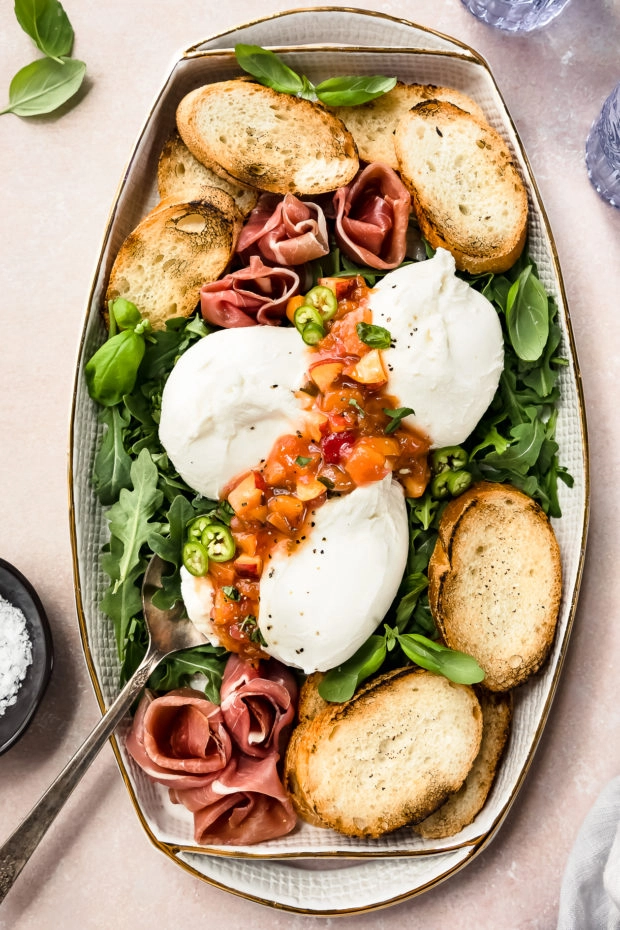
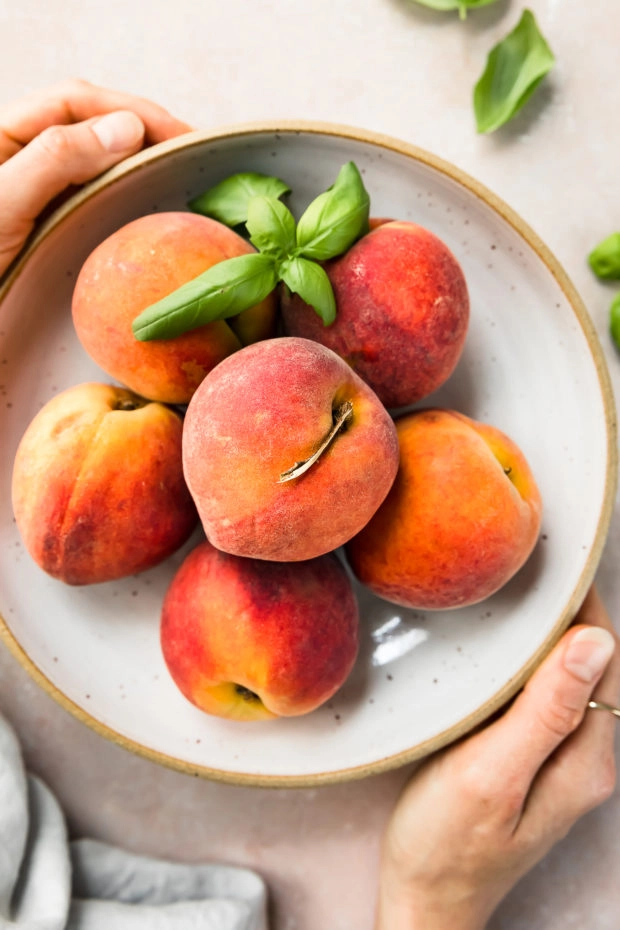
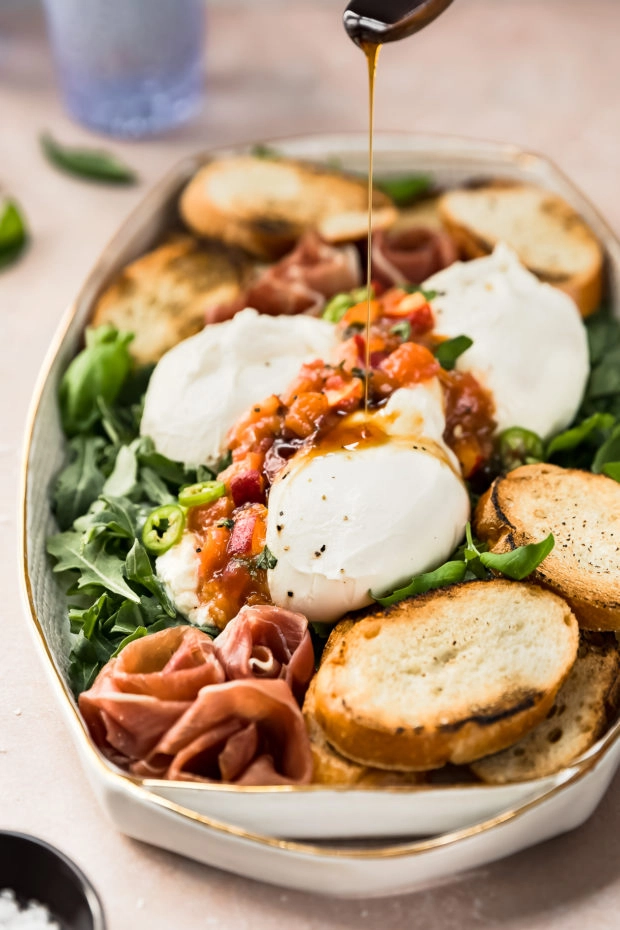
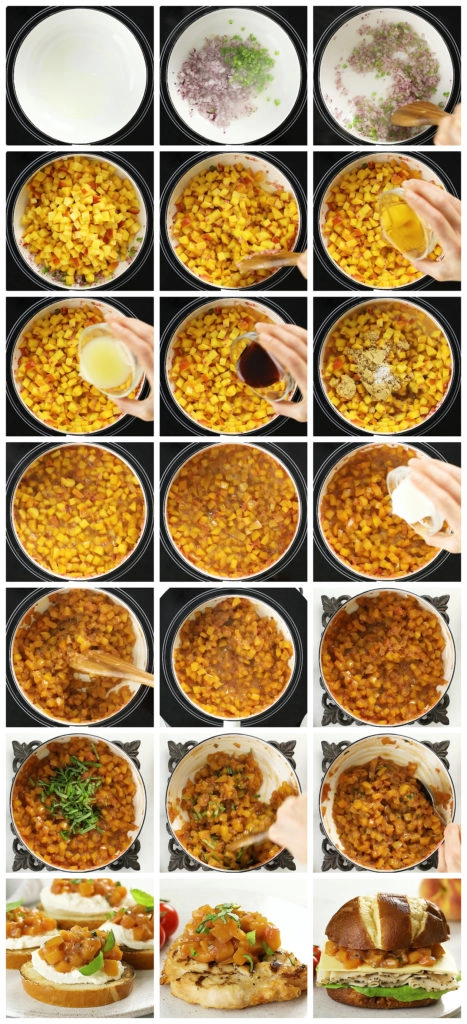
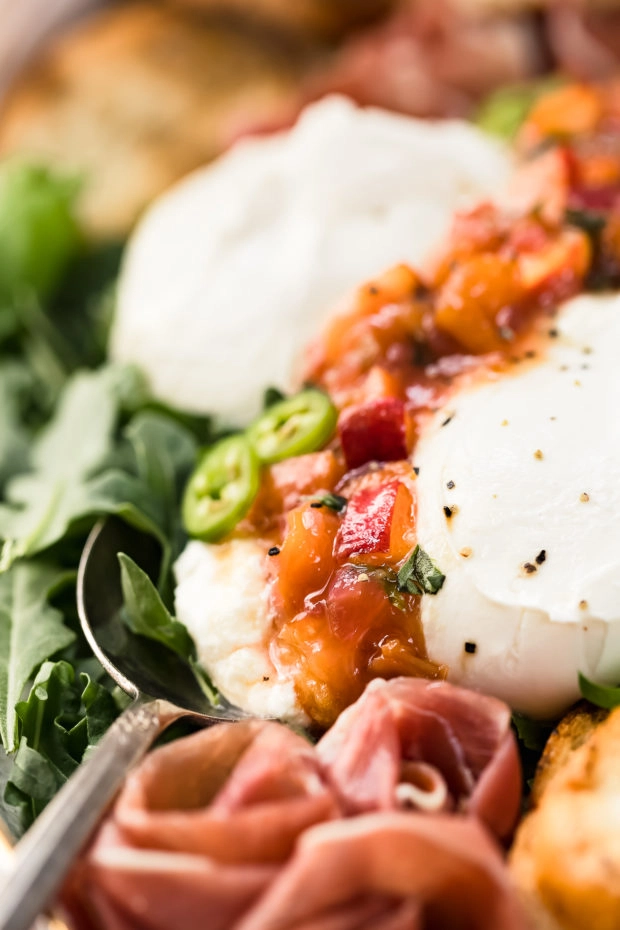
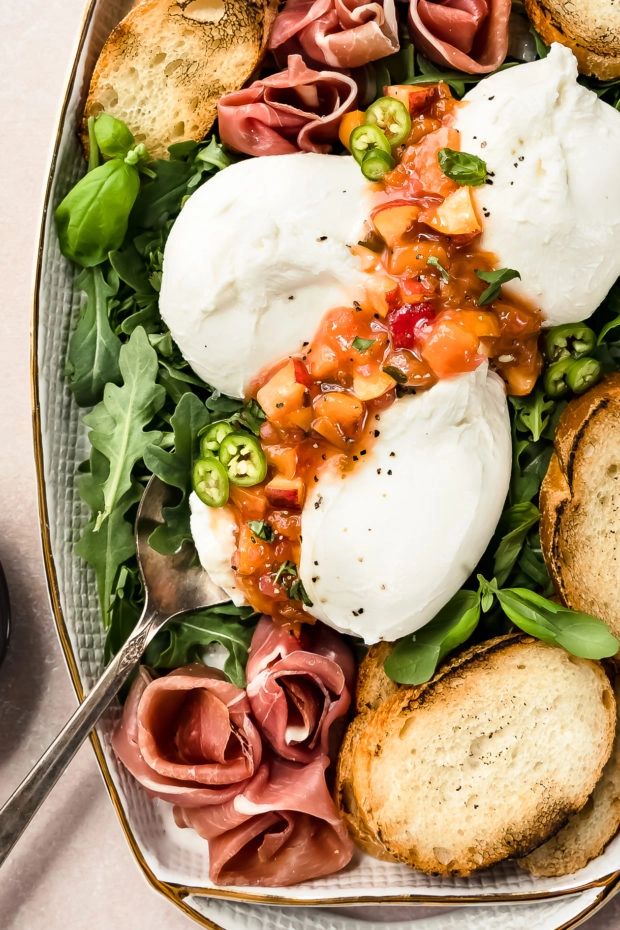
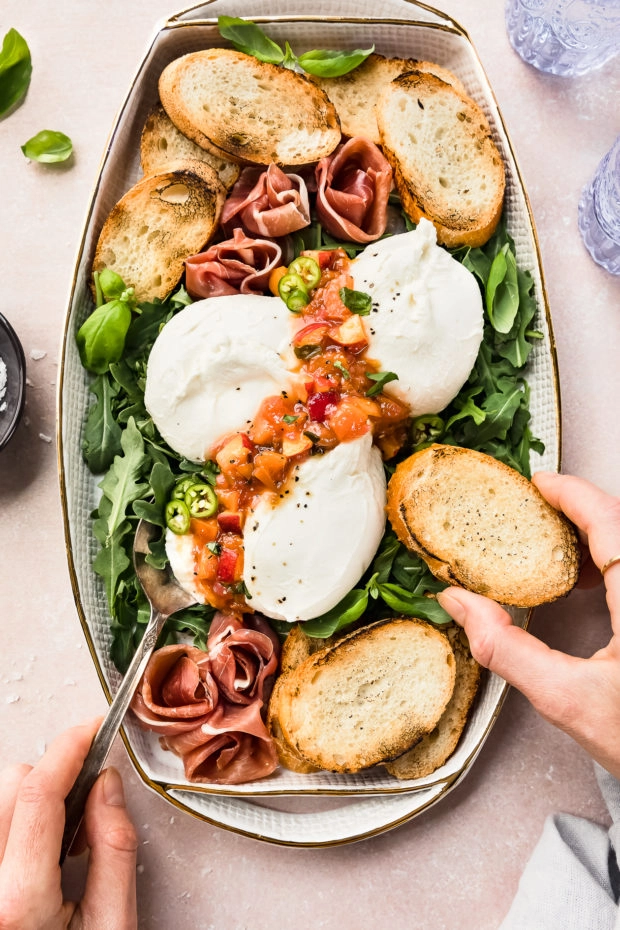
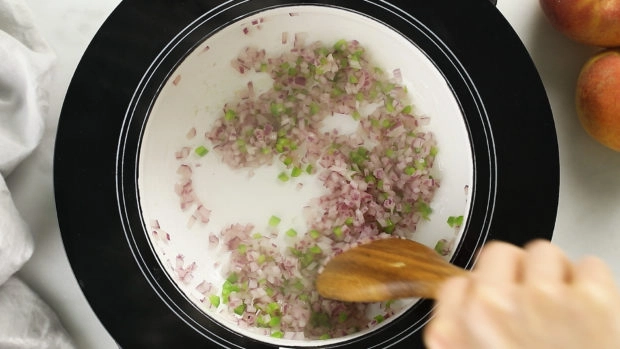
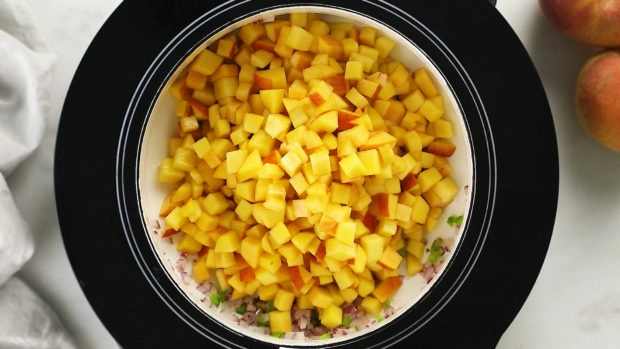
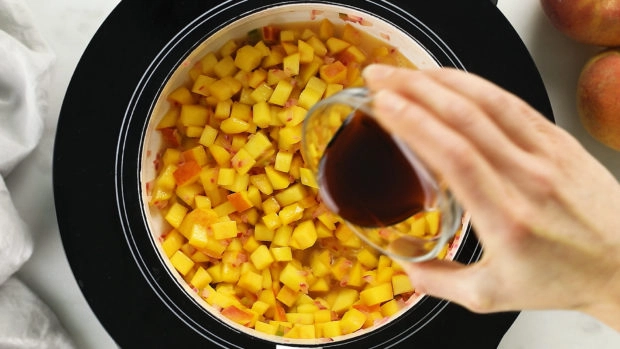
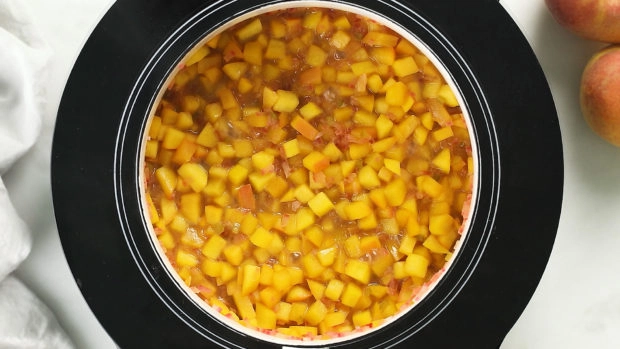
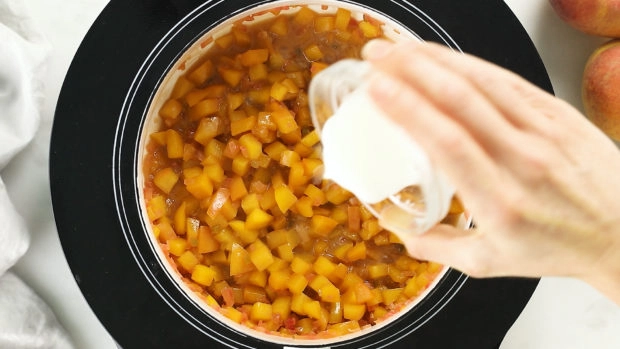
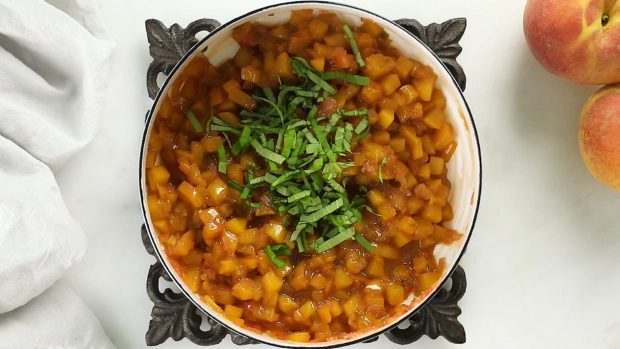

Michele
I wonder, can this recipe be canned?
Cheyanne
Hi Michele,
Great question! Unfortunately, this is not a canning recipe. Please let me know if you have any other questions as I’m always happy to help. Cheers and warm wishes for a wonderful day.
Best,
Cheyanne
Pam
Hi. I’d like to make this to serve with a ham for company. I’ve made chutney in the past and want to include some of your suggested spices but have no idea of how much to add. Would you please respond with your suggested amounts of the cinnamon, ginger, cloves, etc. Thanks much! Can’t wait to make this. I know it will be delicious.
Cheyanne
Hi Pam,
Great question! Unfortunately, I have only made the recipe as instructed. I include variations to encourage readers to make the recipe their own. However, if you are unsure I would just start off with: a generous pinch – up to 1/8 tsp of each spice.
Remember you can always add more, but you can’t take it out once you put it in there, so I advice you err on the side of caution. If you try adding spices I’d love to hear how it turns out! Warmest wishes for a wonderful weekend – And, I hope your ham is a wild success with your friends/family!! Cheers 🙂
Pam
Thanks for your quick reply. Your recommendations are very much in line with my thinking. I will let you know how it turns out.
Cheyanne
My pleasure, Pam! My fingers are crossed everything turns out beautifully! 🙂
Mary Ann | The Beach House Kitchen
I remember this one Chey! I love chutneys and I’ve tried this recipe and it’s delicious! Perfect for those end of summer peaches. Love the new video!
Ashlyn @ F5 Method
I’ve never tried chutney before but this looks like the perfect place to start! What’s the difference between chutney vs jams/jellies? Looks amazing as always Cheyanne! 🙂
Shashi at SavorySpin
I missed this when you first shared it so I’m glad you reposted this one – BTW GORGEOUS, GORGEOUS photos! I grew up on the Indian version of chutney and often get confused when some one offers me a more relish looking version – but, either way, they are all so tasty – and yours is brimming with flavor! I have some extra peaches that I need to turn into THIS! Happy Tuesday, Cheyanne! XOXO
Kelsie | the itsy-bitsy kitchen
OK, can I just eat this chutney with a spoon? It looks SO GOOD! I’m all about peaches right now so I’m pretty much drooling over here. Have a great week, Chey!
Mary Ann | The Beach House Kitchen
I don’t know how I missed this the first time around Chey! Chutneys are one of my all time favorite things to add to my cheeseboards. And how perfect for the season is this one? I’m enjoying all the summer peaches right now before the season comes to an end! Wah wah! Pinned and on my list of things to make!
Kelly | Foodtasia
Chey, this peach chutney has me drooling all over my computer! Love the sweet and spicy flavors going on. It looks so wonderful the way you’ve served it with burrata and toasts – Yum!
Matt – Total Feasts
Oh wow, I love the flavours here. It looks so fresh, especially with the salty meats and burrata. Just what you want for a BBQ side!
Marissa
I adore chutney and what a delicious combination – peach and basil! We’ve been eating peaches like crazy – they’re so good this year. And we have basil growing in the garden, so this is an absolute MUST!
Kevin
I love your flavor combo! I bet this is super refreshing!
Geraldine | Green Valley Kitchen
My dad always made savory chutneys and I loved them – so good in a cheese sandwich! There are peaches everywhere right now, Cheyanne- so this is a perfect way to use them up! Love the sweet and savory combo – and love your presentation – good bread, some cheese and this chutney is all I need for an easy snacky dinner – and a glass of wine too!
marcie
I’ve made a spicy apple chutney and loved it, and this summery peach chutney sounds even better! I could easily make a meal out of this with the bread, greens and cheese…you’ve got all of the food groups here! 🙂
Ben|Havocinthekitchen
Shame on you Chey, indeed! I was thinking just yesterday “It’s almost the end of July, but Chey hasn’t shared her famous summer appetizers yet!” At least you acknowledge your mistakes. And this peach chutney sounds grear, and the entire plate looks just phenomenal that I’m willing to forgive you;)
Saudia
omg! I love this! I am definitely making this the next time I’m entertaining!! thanks so much!
Kelsie | the itsy-bitsy kitchen
All I need is this chutney and some bread and some burrata and I’m a happy camper. SO GOOD! It was worth waiting alllll July for an appetizer :). Have a great weekend, Chey!
Jennifer @ Seasons and Suppers
I can’t imagine anything nice to sit down to this time of year! Will definitely be trying this chutney when local peaches show up here (any day now! 🙂
Danielle
OMG I am drooling! This looks just delicious! I can’t wait to make it cheyanne. I’ve been on a peach grilling kick lately, so totally going to try it with grilled peaches.
angiesrecipes
I eat peach chutney with a big tablespoon!! Yours looks so very yummy that I just want to dig in!